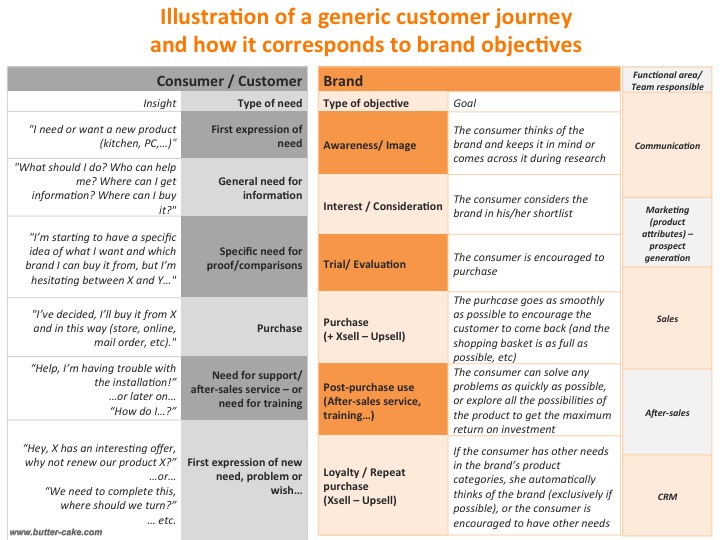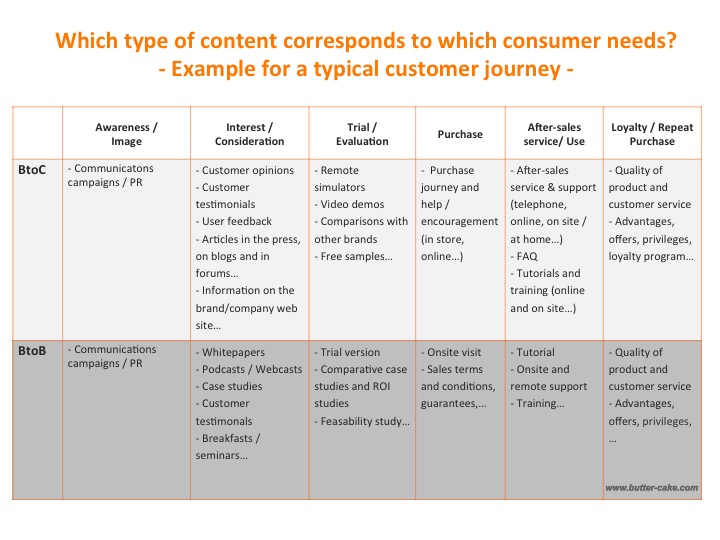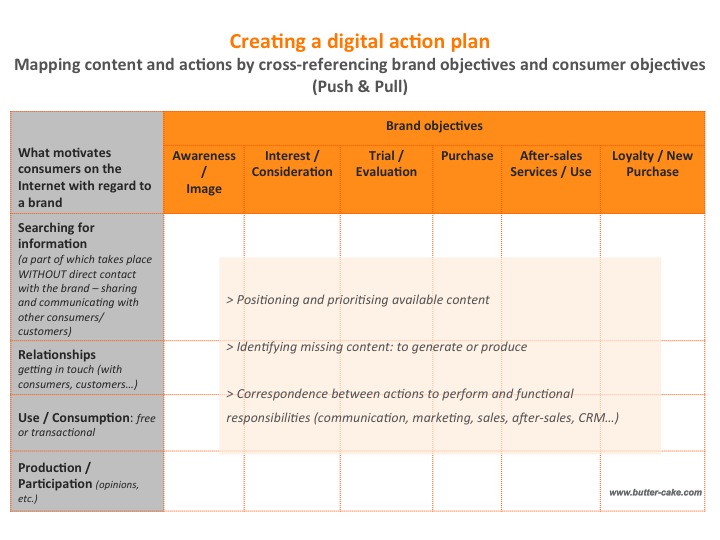Overview: Turning a digital strategy into an action plan is something that should be done in phases to reflect the relative position of the Internet in the overall strategy of means. Using a customer journey and associating different brand goals to it is a way of organising all the content and actions and prioritising them before getting into the detail of the digital action plan. Defining how to steer the project will then be done retroactively.
Today the actions of companies on the Internet do not always necessarily spring from a coherent digital strategy but are often a mix of essential (web site, SEO…) and ad hoc initiatives responding to various demands and opportunities (mobile apps, social networks…). This is what makes it hard or even impossible in some cases to aggregate data and indicators. Only by starting from the brand or company strategy can we come up with an effective digital strategy that allows for the right performance indicators to be set, from the macro-level to the micro-level.
While strategic thinking can be done alongside the company’s current actions, it is also true that when it comes to coming up with a new action plan, it isn’t easy just to rip everything up and start afresh. A double difficulty arises at this stage: how can we transform a digital strategy into a measurable action plan? And how can we hitch our new wagons to the actions already underway for this approach to become reality and not just an academic exercise? Simply break it down into phases, proceeding first to a static “mapping” of the different actions that will provide a comprehensive, non-judgemental view, and then prioritising them and making choices based on goals, means and constraints. Before starting the implementation itself, the action plan must ensure that does not focus short-sightedly on digital elements alone, but that it reflects the relative position of the Internet in the customer journey, in relation to other media and channels: this is how consumers experience it! (Note: here we will detail the approach mainly for marketing and communicatons; nonetheless, it can also be applied in a similar fashion to other targets for the company, for instance HR, etc.).
Phase 1: What is the « customer » journey for my brand?
A customer journey reflects the different phases a consumer goes through before and after purchase, phases that correspond to different actions for the company. The customer journey should not be confused with the journey for in-store purchases, as it has a much wider meaning. It is an approach that is often used in BtoB where sales cycles are long, but it applies equally to BtoC; in the latter case, certain steps may be difficult to differentiate, but in any case reality is never so linear and sequential as the model, which needs to be used to frame our thought process but not set it in stone! When a brand has several products, it can start with a generic customer journey that applies to its category as a whole, and then get into more detail for certain categories/targets. For instance, a furniture manufacturer/distributor might have two customer journeys depending on the level of engagement in a potential purchase (when I’m looking to buy a new kitchen, I think about it a little more carefully than when I’m buying small decorative items or making impulse buys in store) and, if necessary, the company can then differentiate between a “kitchen” customer and one looking to buy a new bed, some living room furniture, etc. It is up to each brand to know the level of detail it requires; however, it is better to avoid getting too specific, especially when there is a risk of getting lost in internal semantic debates that will have marginal impact on the overall effectiveness of actions. The journey shown here is a generic model, and obviously each brand must adapt it to its own circumstances.
Phase 2: What content and actions address each stage of the customer journey?
Once the customer journey is laid out, we need to associate with each phase the content and actions on the part of the brand that correspond to the phase in question. This exercise must be carried out independently of the broadcast channel in the first instance, as some content may be accessed by the consumer via several channels. Unless it is a brand new creation, we rarely start this phase from scratch. The idea is rather to come up with an exhaustive list of all the types of content that exist in the company and arrange them in a user-centric fashion, i.e. in the way a user might request them rather than in terms of the internal department that is in charge of them. This is important because, in reality, content doesn’t fit neatly inside boxes: some very sophisticated content might interest consumers/prospects that are still at an early stage of their journey, while other content might correspond to several phases of the journey… We can thus identify and build modular content that can meet different levels of needs: for instance, customer stories in BtoB can be presented in different ways (a simple list, a text version with a summary of just a few lines, a video, etc.). A prospect who is very early in the purchase process will be satisfied with a quick look at the list of customer references without digging any deeper, and someone who is really interested in the brand will come back later to study one or two of the stories in more detail.
Phase 3: The role digital plays in the customer journey (= why consumers use the Internet and when during a customer journey)
Once we have a complete view of all existing content (or content that needs to be created), depending on the customer journey, we then cross-reference this with user motivations (why are they using the Internet) to determine the role of different digital media/channels in the customer journey. The Internet is a “push” and “pull” media, and as such it is always at the crossroads between brands and consumers, and their respective goals…
Phase 4: How do we prioritise actions depending on the channel?
When the theoretical digital action plan is drawn up, one last step remains before the plan can be implemented: prioritising actions and choosing between some of them according to goals, means and constraints. We can rarely do everything straight away, either due to lack of budget, teams, or time… This decision-making corresponds to the strategy of means that ends up being chosen. Some useful questions to ask yourself to make sure you make the right choices include:
– The role of the Internet in each phase of the journey, compared to other media/channels, and how best to share the budget and the actions between them. For instance, today, if you want to create massive brand awareness for a BtoC brand, there’s nothing better than television. If the company can afford it, the Internet will only play a supporting role to TV or other traditional media at this stage. If the company does not have the necessary budget, it could consider another mix of media (or even go purely digital) but in this case the action would need to be very well targeted to be effective.
– The right balance between “push” content/actions and “pull” content/actions, depending on the experience of the sector and the category of products, the brand strategy, its financial means…
– Essential content/actions versus nice to haves: What content gives me real competitive advantage? What content can consumers not do without, otherwise they won’t trust me? What content is nice but not necessarily useful in the short term?
– Modular content (in terms of format, degree of detail…) and content that can be used by different channels versus “single channel” content.
In conclusion, what links a brand’s strategy and its digital action plan is the customer journey, which lets the brand match actions that serve its immediate goals with actions that allow it to meet the needs of the consumer, and to do so as well as possible. Since consumers/customers are by definition multi-channel, a digital action plan must be designed in relation to other media and channels. The decision-making process used to build the optimum strategy of means is based on the goals, means and constraints of the company, and the content and actions chosen must provide input for the right performance indicators. This approach is not very complicated to implement and has the merit of forcing the company to “settle on” its actions and fit them all together rather than continuing to produce content in isolation. It allows us to identify areas of opportunities and areas where what exists already can be optimised, and to put the actions of the different internal departments into perspective by linking them together. This cannot be done if we have not identified the right performance indicators to monitor, depending on the strategy of the company – and that will be the subject of the next section.
This series of articles is regrouped in the ebook « Building a digital strategy », available for download in PDF format on this site.



